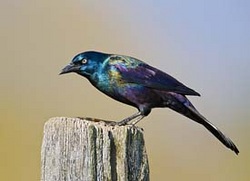Common Grackle (Quiscalus quiscula)

Description: Grackles are usually between 11 and 13.5 inches in size. Both males and female grackles are black with long black legs. Male grackles have iridescent purple heads and iridescent bronze or purple backs.
Habitat: Grackles are commonly found in agricultural fields, towns, pine groves, and along streams.
Diet: Grackles are omnivores, but eat mainly seeds, especially corn. They also hunt for insects, fish, mice, amphibians, and shellfish. They have also been known to eat garbage and other birds.
Behaviors:
Miscellaneous:
Habitat: Grackles are commonly found in agricultural fields, towns, pine groves, and along streams.
Diet: Grackles are omnivores, but eat mainly seeds, especially corn. They also hunt for insects, fish, mice, amphibians, and shellfish. They have also been known to eat garbage and other birds.
Behaviors:
- A grackle’s call is usually described as a series of short “chack” sounds followed by the sound of a rusty gate squeaking shut
- Grackles are a species that “ant”- that is, they allow ants to crawl over them to destroy parasites with the formic acid they secrete.
- Grackles tend to roost and forage together in large flocks during the winter
- A clutch is made up of one to seven eggs, which vary in color from blue to brown. They incubate for eleven to fifteen days.
- A grackle nest is a cup made from twigs, leaves, grass, and anything else a female can find. It is reinforced with mud.
- A male grackle performs a courtship dance for a female, consisting of a series of jerky movements. This is combined with squealing, to gain its potential mates’ attention.
- Grackles live year-round in the eastern half of the United States, and some migrate to southern Canada and the western half of the United States for the spring.
Miscellaneous:
- Scarecrows are used to chase off grackles more often than they are their namesake, the American Crow.

